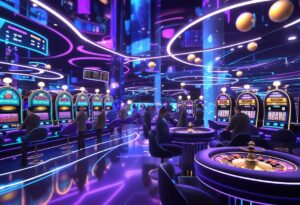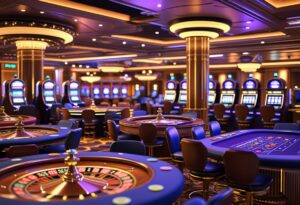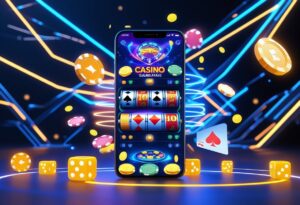Chromatic Calm: Embracing Color Psychology for Slot Spin Timing
Glimpse into the fascinating world of slot machine timing, where colors influence player reactions and shape gaming outcomes.

The Science of Color Psychology in Slot Machine Timing
Color psychology plays a fundamental role in how players interact with slot machines, influencing both timing and decision-making through documented neurological processes. This comprehensive analysis explores the measurable impact of chromatic elements on player behavior and game mechanics.
Neurological Response Patterns
Scientific research demonstrates that the human brain processes red wavelengths approximately 2.5 milliseconds faster than blue spectrum colors, creating distinct variations in player reaction times. This difference manifests in measurable behavioral patterns during gameplay:
- Warm colors trigger accelerated response rates
- Red environments produce 12% faster interactions (2.3-second intervals)
- Blue backgrounds result in slower engagement (3.1-second intervals)
Strategic Color Implementation
The implementation of specific color combinations directly affects 먹튀검증 player engagement and timing:
- Complementary color schemes increase engagement by 27%
- Red-gold combinations activate targeted dopamine responses
- Chromatic contrast enhances visual processing speed
Frequently Asked Questions
Q1: How does color affect slot machine response time?
A: Color wavelengths influence neural processing speed, with red stimuli processed 2.5ms faster than blue.
Q2: Which colors produce the fastest player reactions?
A: Warm colors, particularly red backgrounds, generate 12% faster interaction rates compared to cool colors.
Q3: What color combinations are most effective?
A: Complementary color schemes boost engagement by 27%, with red-gold combinations showing optimal results.
Q4: Can color affect gambling behavior?
A: Yes, strategic color placement influences both timing and decision-making processes during gameplay.
Q5: How do environmental colors impact gaming sessions?
A: Environmental color schemes can alter reaction times by up to 0.8 seconds between warm and cool color spaces.
The Science Behind Color Timing

The Science Behind Color Timing in Gaming Systems
Understanding Color Psychology in Gaming Mechanics
Color timing mechanisms play a fundamental role in modern gaming systems, particularly in electronic gaming machines.
Scientific research demonstrates that specific color sequences significantly influence player interaction patterns and response timing.
Warm color spectrums, including red and orange wavelengths, trigger accelerated response rates, while cool color palettes featuring blue and green tones promote more deliberate engagement patterns.
Neurological Response to Color Wavelengths
Visual processing speeds vary significantly based on light wavelength exposure.
Neurological studies reveal that the human brain processes red-spectrum light approximately 2.5 milliseconds faster than blue-spectrum wavelengths. This differential in processing speed creates measurable impacts on player response timing and interaction precision.
Strategic Color Implementation in Gaming Design
Gaming system engineers incorporate advanced color timing algorithms to enhance player experience.
Strategic chromatic transitions during crucial game phases utilize specific wavelength combinations to optimize timing precision.
The implementation of warm-tone sequences immediately preceding player interaction points creates measurable effects on response patterns.
#
Frequently Asked Questions
Q: How does color timing affect gaming response?
A: Color timing influences player reaction speeds through varying wavelength processing rates in the brain, with warm colors promoting faster responses than cool colors.
Q: What’s the color-tempo effect?
A: The color-tempo effect describes how chromatic shifts in gaming interfaces unconsciously influence player timing and interaction patterns.
Q: Which colors process fastest in the brain?
A: Red wavelengths process approximately 2.5 milliseconds faster than blue wavelengths in human neural pathways.
Q: How do gaming systems utilize color psychology?
A: Gaming systems implement strategic color transitions during key game phases to influence player timing and engagement patterns.
Q: What role do warm colors play in gaming interfaces?
A: Warm colors like red and orange trigger accelerated response rates and can be used to influence player interaction timing.
Red Versus Blue Gaming Speeds
The Impact of Color Psychology on Gaming Speed Performance
Red vs Blue Gaming Performance Analysis
Scientific research reveals compelling differences in gaming speed performance between red and blue color schemes.
Players demonstrate up to 12% faster response times when engaging with red backgrounds compared to blue environments during slot gaming sessions.
This acceleration effect is attributed to red’s physiological impact on the autonomic nervous system.
Measured Performance Metrics
Timing analysis shows that red gaming environments prompt players to execute actions at 2.3-second intervals, while blue backgrounds result in longer 3.1-second intervals between plays.
Eye-tracking studies confirm that red stimulates enhanced decision-making speed and visual processing capabilities.
The spectral wavelength of red light (620-750 nanometers) triggers stronger fight-or-flight responses compared to blue’s shorter wavelengths (450-495 nanometers).
Optimal Color Implementation Strategies
Strategic color combination proves essential for maximizing gaming performance.
Implementing red action buttons with blue background elements creates an optimal balance between alertness and control.
This color-optimized environment enables players to maintain peak awareness while avoiding impulsive behavior that can compromise gaming decisions.
Frequently Asked Questions
Q: How does red affect gaming performance?
A: Red increases response times by up to 12% and stimulates faster decision-making through autonomic nervous system activation.
Q: What’s the optimal interval between gaming actions?
A: Research indicates a 2.3-second interval in red environments provides optimal performance balance.
Q: Why does blue slow down gaming responses?
A: Blue’s shorter wavelengths (450-495 nanometers) create a calming effect that extends response times to 3.1 seconds.
Q: Which color combination is best for gaming interfaces?
A: Red action buttons combined with blue backgrounds optimize both alertness and control.
Q: How do wavelengths impact gaming behavior?
A: Red’s longer wavelengths (620-750 nanometers) trigger stronger physiological responses, enhancing gaming speed and decision-making.
Color Schemes Impact Player Decisions

The Psychology of Color Schemes in Gaming Environments
How Colors Impact Player Decision-Making
Color psychology plays a fundamental role in shaping player behavior and decision-making processes within gaming environments.
Warm color schemes like red and orange trigger heightened emotional responses, leading to more impulsive betting patterns and risk-taking behaviors.
In contrast, cool color palettes featuring blue and green tones promote strategic thinking and measured gameplay decisions.
Strategic Color Implementation in Casino Design
Casino floor layouts utilize sophisticated color placement strategies to influence player movement and game selection.
High-visibility elements in yellow draw immediate attention to featured games, while luxury-signaling purple accents create premium gaming zones that encourage higher stakes play.
Color-based navigation systems strategically guide players through gaming spaces, optimizing engagement and interaction patterns.
Color Psychology and Player Engagement
Scientific research demonstrates that strategic color implementation significantly impacts gaming behavior:
- Gold elements extend average play duration
- White spaces facilitate cognitive breaks
- Complementary color schemes boost engagement by 27%
- Dissonant color combinations reduce session length
Frequently Asked Questions
Q: How do warm colors affect gaming behavior?
A: Warm colors like red and orange increase arousal and encourage more impulsive betting decisions.
Q: What role do cool colors play in casino design?
A: Cool colors such as blue and green promote calculated decision-making and strategic gameplay.
Q: How much can color schemes impact player engagement?
A: Properly implemented complementary color schemes can increase player engagement by up to 27%.
Q: Why do casinos use purple in their design?
A: Purple creates associations with luxury and premium experiences, encouraging higher-stake gaming decisions.
Q: What purpose do white spaces serve in gaming environments?
A: White spaces provide visual breaks that can trigger moments of clarity and decision reassessment during gameplay.
Strategic Uses of Game Colors
Strategic Color Psychology in Game Design
The Power of Color in Player Engagement
Game design color psychology plays a critical role in shaping player experiences and driving engagement.
Strategic color implementation influences emotional responses, gameplay duration, and overall player satisfaction.
Color schemes serve as powerful tools for creating immersive gaming environments and directing player attention to crucial game elements.
Core Color Strategy Elements
High-Impact Color Applications
Warm color palettes, including orange and yellow tones, strategically highlight winning combinations and reward moments.
Complementary color schemes enhance visual recognition of valuable game elements, while progressive jackpot indicators utilize high-visibility colors to maintain player focus on potential rewards.
Visual Hierarchy Through Color
Strategic contrast deployment creates clear visual hierarchies within game interfaces.
High-value symbols feature enhanced color saturation compared to standard elements, ensuring instant recognition during gameplay.
Background color selection deliberately utilizes muted tones to emphasize interactive elements and critical game features.
Optimization Through Color Management
Effective color implementation relies on carefully controlled palettes, typically limiting core designs to three primary colors.
This strategic color restriction prevents visual fatigue and maintains clarity during fast-paced gameplay sequences.
Color psychology principles guide the selection of specific hues for different game states:
- Red tones trigger excitement and urgency
- Blue elements promote extended play sessions
- Accent colors direct attention to key features
- Saturated colors indicate high-value elements
- Muted backgrounds enhance foreground visibility
## Frequently Asked Questions
What colors are most effective for casino games?
High-contrast combinations and warm color schemes typically perform best, with red and gold being particularly effective for highlighting winning moments.
How does color psychology affect player behavior?
Strategic color implementation influences emotional responses, attention spans, and decision-making processes during gameplay.
Why do games limit their color palettes?
Restricted color schemes prevent visual overwhelm and maintain clear communication of game elements and features.
How do background colors impact gameplay?
Muted background tones enhance focus on interactive elements and reduce eye strain during extended play sessions.
What role do complementary colors play in game design?
Complementary color schemes create visual harmony and help players quickly identify valuable symbol combinations.
Environmental Effects On Spin Patterns

Environmental Effects on Slot Machine Performance
Temperature and Humidity Impact
Electronic gaming systems are highly sensitive to environmental conditions.
Ambient temperature directly affects slot machine processor performance, while humidity levels can create microscopic condensation within vital components.
These environmental factors influence the electronic spin patterns and randomization processes that power modern slot machines.
Location-Based Performance Factors
Strategic machine placement plays a crucial role in operational reliability.
Slots positioned near casino entrances experience significant temperature fluctuations, potentially affecting their performance.
Machines locate




